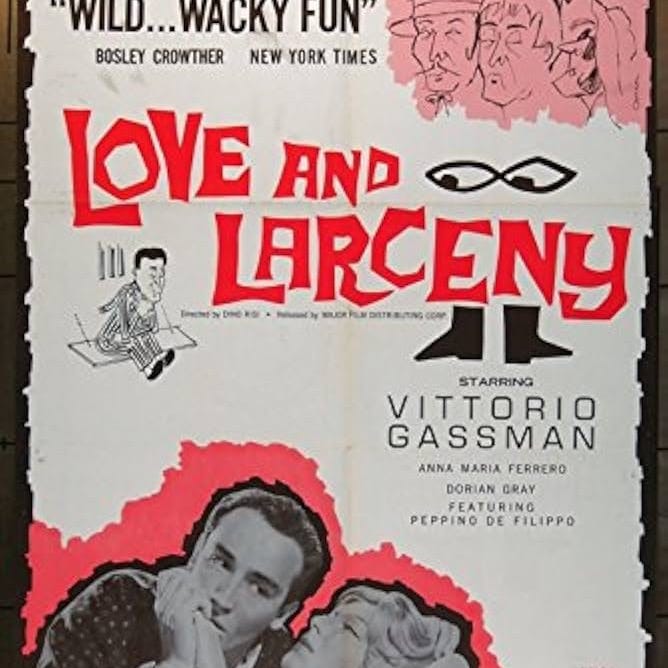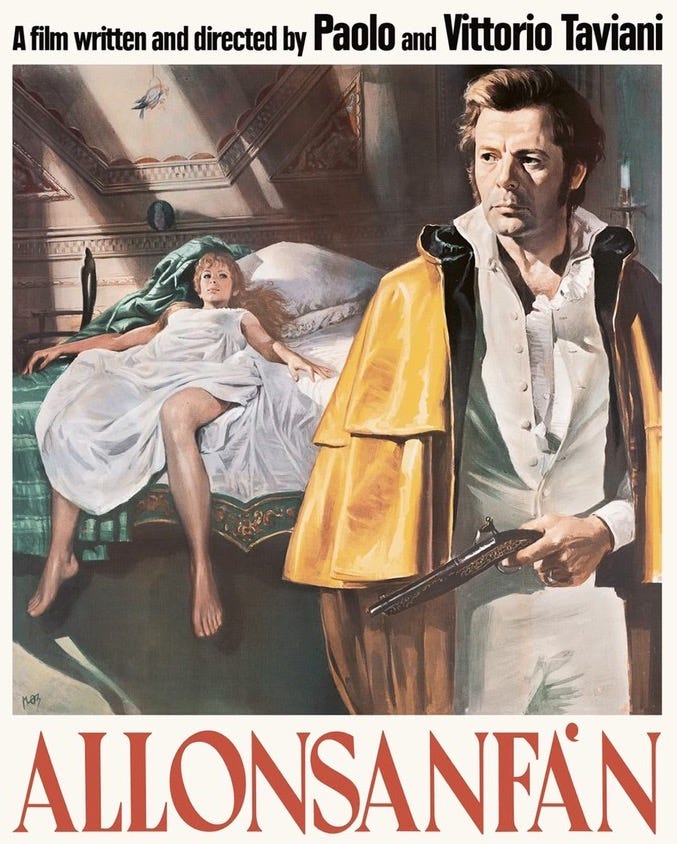Ciao! Escape the Ordinary in Italian Cinema
Why doom scroll when you can journey to Italy?
Last summer, my wife and I took a glorious trip to Milan and the Lake Country near Bellagio for our 15th wedding anniversary. It was our third Italian pilgrimage—Tuscany for our honeymoon, then Rome/Sorrento/Capri for her 40th. Each visit deepens my attachment to this country where mind-blowing beauty and chaotic life exist in perpetual tension.
But beyond Fellini's canonized works and Rossellini's war trilogy, my Italian film education remained fairly limited. So as the news darkened over the past few months, I’ve found a tremendous amount of meaning and entertainment within Italian cinema's startling range.
These are comedies that cut deeper than most dramas, genre films that function as political treatises, and human portraits of devastating precision. Humanistic, alive and filled with physical and moral beauty.
A perfect antidote to the daily headlines.
Here are the standouts from my recent deep dive.1
1. IL SORPASSO (Dino Risi, 1962)
Thinking of "Wild Strawberries" while watching this film—but with less obvious pathos and infinitely more fun. Risi's road movie pairs Gassman's charismatic bulldozer Bruno with a shy law student for a weekend joyride capturing Italy between post-war recovery and economic boom. Gassman should be insufferable, but you can't take your eyes off him.
The camera becomes a character—racing alongside the car, then maintaining ominous distance. Perfect visualization of Italy's "economic miracle" with all its excitement and hidden costs. Every frame delivers immediate pleasure while building critique of a society moving too fast to see what it's leaving behind.
WHERE TO WATCH:
STREAMING: Available on Apple TV (rent/purchase), The Criterion Channel, and Internet Archive.
PHYSICAL MEDIA:
Criterion Collection Blu-ray with extensive special features
Part of Radiance Films' "Commedia all'Italiana: Three Films by Dino Risi" (2023) box set featuring a new 4K restoration
FREE OPTION: Available on Internet Archive
2. NIGHTS OF CABIRIA (Federico Fellini, 1957)
An inside-out Noir—this underseen Fellini classic inverts tropes. There’s a direct through-line to Sean Baker's work in Red Rocket and Anora. Those films adopt this neorealist aesthetic as Fellini shows the way. This is an all-time performance as Cabiria, a streetwise prostitute whose indestructible optimism gets tested across Rome.
Fellini's Rome isn't backdrop but ecosystem—each location revealing another facet of a society where glamour and poverty coexist. His camera moves from cramped streets to opulent mansions, creating a visual map of class divisions that Cabiria navigates with stubborn dignity.
WHERE TO WATCH:
STREAMING: Available for rent/purchase on Amazon Video, Apple TV, and Fandango at Home.
PHYSICAL MEDIA: Criterion Collection Blu-ray
FREE OPTION: Available on Internet Archive
3. LOVE AND LARCENY (Dino Risi, 1960)
Why doesn't every movie have beautiful people, running ridiculous scams, in picturesque Italian settings, while dressed impeccably? Risi's con artist comedy follows Gassman through elaborate swindles targeting every level of Italian society. Each scam reveals another aspect of a culture where appearance trumps substance. Gassman's charisma makes him Risi's perfect vehicle—you can't help rooting for him even as you recognize he's just a more honest version of the respectable figures he impersonates.
The visual pleasure is off the charts—perfectly composed shots of Roman streets and elegant interiors that make criminality look like natural response to a society built on facades. The economic miracle becomes a confidence game where prosperity masks inequality, yet the film never feels bitter. Critique through sparkling comedy—entertainment and intelligence as natural partners.
WHERE TO WATCH:
STREAMING: Limited availability online.
PHYSICAL MEDIA:
Featured as "Il Mattatore" in Radiance Films' "Commedia all'Italiana: Three Films by Dino Risi" (2023) box set, marking its English-subtitled Blu-ray debut with extensive special features
THEATRICAL: Occasionally screened at film festivals and specialized theaters.
4. IL POSTO (Ermanno Olmi, 1961)
Italian Neo-neo realism? What a sweet, lovely little film. Feels like watching a college graduate start their first desk job—that mix of excitement, disorientation, and quiet disappointment. Olmi follows young Domenico securing "il posto"—the position—at a massive corporation, bringing documentary precision to modern work rituals: absurd aptitude tests, bureaucratic job assignments, sad office parties.
Olmi finds beauty in mundane moments—nervous glances between Domenico and Antonietta, awkward elevator silences, precise movements of office workers. Fluorescent-lit workspaces transformed into Renaissance-worthy compositions. Without a single speech about capitalism, he creates one of cinema's most devastating portraits of institutional life. The final image—Domenico at his assigned desk—hits harder than any dramatic confrontation.
WHERE TO WATCH:
STREAMING: Available on The Criterion Channel.
PHYSICAL MEDIA: Radiance Films brand new remaster
FREE OPTION: Also accessible on Internet Archive in multiple formats
5. HOW TO KILL A JUDGE (Damiano Damiani, 1975)
I liked this better as a whodunit than a big exploration of the mafia or Italian social mores. That's the beauty of Italian genre films—compelling mysteries functioning as sophisticated political allegories. Franco Nero plays a filmmaker whose movie about a judge's assassination mirrors a real murder. When he investigates, the boundaries between art and reality blur, creating a thriller about cinema's power and limitations.
Visual strategy moves between artificial sets and actual Sicilian locations, creating tension between representation and reality. Investigation scenes shot with procedural precision, then shifting to expressionism for moral implications. Sicily isn't picturesque backdrop but contested territory where state authority and criminal power blur. Murder mystery evolves into examination of how narratives shape truth—a thriller that makes you re-examine what thrillers do.
WHERE TO WATCH:
STREAMING: Available on Amazon Prime via Fandor subscription
PHYSICAL MEDIA: Radiance Films' "Cosa Nostra" Blu-ray Box Set (released August 15, 2023), contains three Damiani mafia films with Franco Nero. Previous Blue Underground DVD is now out of print.
6. WHAT HAVE THEY DONE TO YOUR DAUGHTERS? (Massimo Dallamano, 1974)
My first “Giallo” and it did not disappoint. Great car chases, sick and twisted plot, corruption and genuine intrigue. The motorcycle killer with the huge axe is a signature villain for the ages. Dallamano combines giallo's stylized violence with procedural realism, creating a hybrid that delivers visceral thrills and social commentary. Investigation into teenage suicide expands into something more disturbing—exploitation connecting every level of Italian society.
Visual approach shifts between documentary observation and expressionistic flourishes—gritty realism for investigation, stylized lighting for violence that transforms brutality into terrible beauty. Action sequences executed with technical brilliance while maintaining moral focus. Camera doesn't just observe but implicates, making viewers question their relationship to on-screen violence. Genre cinema with genuine purpose.
WHERE TO WATCH:
STREAMING: Limited availability on regular platforms.
PHYSICAL MEDIA: Arrow Video Special Edition Blu-ray with extensive extras including rare footage and interviews.
ALTERNATIVE TITLE: The film is sometimes listed as "The Police Want Help" or by its Italian title "La Polizia Chiede Aiuto"
7. ALLONSANFAN (Paolo and Vittorio Taviani, 1974)
Without looking, I'm guessing Wes Anderson is a fan. The Taviani brothers create a visual feast anticipating Anderson's meticulous aesthetic—carefully composed tableaux and theatrical blocking. But where Anderson's style often creates emotional distance, the Tavianis achieve both formal rigor and visceral impact. Their story of Mastroianni's disillusioned revolutionary balances precise composition with historical weight. Perfectly symmetrical arrangements and painterly lighting would fit in Anderson's universe, but with political urgency his work rarely achieves.
The dance sequence, scored to Morricone's haunting "Rabbia e Tarantella" (later borrowed by Tarantino), achieves perfect fusion of music, movement, and meaning—a scene Anderson would admire but might not infuse with the same gravity. Documentary elements combined with operatic flourishes create a style simultaneously historical and contemporary.
WHERE TO WATCH:
STREAMING: Limited availability online.
PHYSICAL MEDIA: Radiance Films Limited Edition Blu-ray (February 2024 release), new 2K restoration with extensive bonus features. Also available from DiabolikDVD.
NOTE: This film was long unavailable in quality formats until Radiance's recent restoration.
ON PRESERVATION AND ACCESS
The irony isn't lost on me—our "age of availability" has created new forms of scarcity. Several masterpieces in this list remain frustratingly difficult to access.
The boutique physical media market (Criterion, Arrow Video, Radiance Films) has become the last refuge for these works, protecting them from streaming's ephemeral nature.
This is precisely why physical media collections remain vital cultural repositories rather than mere nostalgic indulgences.
Own your media!
Many of these films are not obviously available on the main streaming services — BUT I’ve provided links for streaming or purchase wherever possible.








